*NURSING > QUESTIONS & ANSWERS > HESI FINAL EXAM COMPREHENSIVE STUDY GUIDE (CORRECT ANSWERS AND RATIONALE): UPDATED 2020 Chamberlain (All)
HESI FINAL EXAM COMPREHENSIVE STUDY GUIDE (CORRECT ANSWERS AND RATIONALE): UPDATED 2020 Chamberlain College Of Nursing
Document Content and Description Below
HESI FINAL EXAM COMPREHENSIVE STUDY GUIDE A nurse in the pediatrician's office is checking the Babinski reflex in a 3-month-old infant. The nurse determines that the infant's response is normal ... if which of the following findings is noted? A The infant turns to the side that is touched. B The fingers curl tightly and the toes curl forward. C The toes flare and the big toe is dorsiflexed. D There is extension of the extremities on the side to which the head is turned, with flexion on the opposite side. 2. A nurse is assessing language development in a toddler from a bilingual family. The nurse expects that the child’s language development: A Is slower than expected B Is developing as expected C Is more advanced than expected D Will require assistance from a speech therapist 3. A nurse notes the presence of variable decelerations on the fetal heart rate monitor strip and suspects cord compression. The nurse should immediately: A Notify the nurse-midwife or physician B Perform a vaginal examination on the mother C Position the mother so that her hips are elevated D Insert a gloved finger into the mother's vagina to feel for cord compression 4. ID: 283573402 A nurse is assessing the language development of a 9-month-old infant. Which developmental milestone does the nurse expect to note in an infant of this age? A The infant babbles. B The infant says "Mama." C The infant smiles and coos. D The infant babbles single consonants. 5. ID: 283572566 A nurse is taking the vital signs of a woman who delivered a healthy newborn 1 hour ago. The nurse notes that the woman's radial pulse rate is 55 beats per minute. On the basis of this finding, which action by the nurse is most appropriate? A Documenting the finding B Helping the woman get out of bed and walk C Performing active and passive range-of-motion exercises D Reporting the finding to the nurse-midwife or physician immediately 6. ID: 283572928 A nurse is caring for a pregnant client in the labor unit who suddenly experiences spontaneous rupture of the membranes. On inspecting the amniotic fluid, the nurse notes that it is clear, with creamy white flecks. What is the most appropriate action for the nurse to take on the basis of this finding? A Document the findings. B Check the client's temperature. C Report the findings to the nurse-midwife. D Obtain a sample of the amniotic fluid for laboratory analysis. 7. ID: 283574659 The mother of a toddler asks the nurse when she will know that her child is ready to start toilet training. The nurse tells the mother that which of the following observations is a sign of physical readiness? A The child has been walking for 2 years. B The child can eat using a fork and knife. C The child no longer has temper tantrums. D The child can remove his or her own clothing. 8. ID: 283572518 A nurse is gathering subjective data from a client who is seeking a prescription for an oral contraceptive. To identify risk factors associated with the use of an oral contraceptive, which question does the nurse ask? A "Are you dieting?" B "Do you smoke cigarettes?" C "Do you engage in strenuous exercise such as jogging?" D "Do you normally have menstrual cramps with your periods?" 9. ID: 283573484 A nurse provides information to a pregnant client with hemorrhoids about measures that will alleviate her discomfort. Which of the following actions does the nurse tell the client to take? Select all that apply. A Sleep lying on her back B Shower daily but avoid sitting in a bathtub C Apply cool compresses to the hemorrhoids Correct D Contact the nurse-midwife if any bleeding occurs E Elevate her hips on a pillow when resting or during sleep Correct 10. ID: 283572560 A nurse is preparing to assess the fetal heart rate (FHR) of a client who is 14 weeks pregnant. Which piece of equipment does the nurse use to assess the FHR? A Fetoscope B Stethoscope C Doppler transducer Correct D Pulse oximetry on the client and a fetoscope 11. ID: 283572504 A nurse observes a nursing assistant communicating with a hearing-impaired client in later adulthood. The nurse should intervene if the nursing assistant: A Uses short sentences B Overarticulates words Correct C Uses facial expressions or gestures D Speaks at a normal rate and volume 12. ID: 283572964 A prescription is written to administer hepatitis B vaccine (Recombivax HB) to a newborn infant. Before administering the vaccine, the nurse should: A Check the infant for jaundice B Check the infant's temperature C Obtain parental consent to administer the vaccine D Request that a hepatitis blood screen be performed on the infant 13. ID: 283574670 A home health care nurse is visiting a male African-American client who was recently discharged from the hospital. Which family member does the the nurse ensure is present when teaching the client about his prescribed medications? A The client's son B The client's father C The client's mother Correct D The client's grandson 14. ID: 283572522 A nurse-midwife, performing a vaginal examination of a client who suspects that she is pregnant, documents the presence of the Chadwick sign. The nurse reads the client's record and interprets this sign as indicating: A A thinning of the cervix B A positive sign of pregnancy C That cervical softening is present D That the cervix was seen to be violet 15. ID: 283573822 A nurse is monitoring the amount of lochia drainage on a perineal pad in a woman who is 1 hour postpartum and notes a 5-inch bloodstain (see figure). How does the nurse report the amount of lochial flow? A Scant B Light C Moderate Correct D Heavy 16. ID: 283574613 A nurse is planning dietary measures for an older client who is experiencing dysphagia. Which of the following actions should the nurse include in the plan of care? A Encouraging the client to feed herself B Ensuring that most of the diet consists of liquids C Monitoring the client during meals to ensure that food is swallowed D Consulting with the physician regarding feeding through an enteral tube 17. ID: 283572526 According to Erik Erikson’s developmental theory, which of the following choices are developmental tasks of the middle adult? A Redefining self-perception and capacity for intimacy B Providing guidance during interactions with his children C Verbalizing readiness to assume parental responsibilities D Making decisions concerning career, marriage, and parenthood 18. ID: 283572980 A nurse is monitoring a woman who is receiving oxytocin (Pitocin) to induce labor. Which action should the nurse, on suddenly noting the presence of late decelerations on the fetal heart rate (FHR) monitor, take first? A Stopping the oxytocin infusion Correct B Notifying the nurse-midwife or physician C Checking the woman's blood pressure and pulse D Increasing the intravenous (IV) rate of the nonadditive solution 19. ID: 283573877 A school nurse provides information to the parents of school-age children regarding appropriate dental care. The nurse tells the parents that their children should: A Brush their teeth every morning and at bedtime Incorrect B Brush and floss their teeth after meals and at bedtime Correct C Brush and floss their teeth every morning and at bedtime D Brush their teeth every morning and at bedtime and floss the teeth once a day, preferably at bedtime 20. ID: 283572099 A community health nurse is providing information to a group of older clients about measures to decrease the risk of contracting influenza during peak flu season. The nurse tells the clients that: A It is best to do grocery shopping and other errands late in the day B They must stay in the house and ask a neighbor or family member to run their errands C Drinking eight 8-oz glasses of fluid each day will reduce the risk of contracting influenza D Wearing a scarf around the nose and mouth will help reduce the transmission of airborne viruses Correct 21. ID: 283572902 A mother of twin toddlers tells the nurse that she is concerned because she found her children involved in sex play and didn't know what to do. The nurse should tell the mother: A To separate her children during playtime B That if the behavior continues, she will need to bring her children to a child psychologist C That if she notes the behavior again she should casually tell her children to dress and to direct them to another activity Correct D To tell her children that what they are doing is bad and that they will be punished if they are caught doing it again 22. ID: 283572907 The mother of a 9-month-old infant calls the nurse at the pediatrician's office, tells the nurse that her infant is teething, and asks what can be done to relieve the infant's discomfort. The nurse instructs the mother to: A Schedule an appointment with a dentist for a dental evaluation B Rub the infant's gums with baby aspirin that has been dissolved in water C Obtain an over-the-counter (OTC) topical medication for gum-pain relief D Give the infant cool liquids or a Popsicle and hard foods such as dry toast Correct 23. ID: 283573472 A nurse, monitoring a client in the fourth stage of labor, checks the client's vital signs every 15 minutes. The nurse notes that the client's pulse rate has increased from 70 to 100 beats per minute. On the basis of this finding, which priority action should the nurse take? A Checking the client's uterine fundus Correct B Notifying the nurse-midwife immediately C Documenting the vital signs in the client's medical record D Continuing to check the client's vital signs every 15 minutes 24. ID: 283574311 The nurse provides information to a pregnant client who is experiencing nausea and vomiting about measures to relieve the discomfort. Which statement by the mother indicates the need for further information? A "I need to avoid eating fried or greasy foods." B "I need to be sure to drink adequate fluids with my meals." Correct C "I should eat five or six small meals a day rather than three full meals." D "I should keep dry crackers at my bedside and eat them before I get out of bed in the morning." 25. ID: 283572558 The parents of an adolescent tell the school nurse that they are frustrated because their daughter has become self-centered, lazy, and irresponsible. The nurse should tell the parents: A That this is normal behavior for an adolescent Correct B To restrict any social privileges until the behavior stops C That this type of behavior is usually the result of parents' spoiling a child D That their daughter will need to see a child psychologist if the behavior continues 26. ID: 283574334 A pregnant client tells the nurse that she has a 2-year-old child at home and expresses concern about how the toddler will adapt to a newborn infant’s being brought into the home. Which of the following statements is the most appropriate response for the nurse to make to the client? A "Don’t be concerned; any 2-year-old would welcome a newborn." B "If your 2-year-old becomes angry or jealous, you should have the child seen by a child psychologist." C "A 2-year-old toddler will be more concerned about exploring the environment, so there’s no reason to be concerned." D "Even though a 2-year-old may have little perception of time, if any changes in sleeping arrangements need to be made for the newborn they should be carried out several weeks before birth." Correct 27. ID: 283573810 A nurse provides instructions to a mother of a newborn infant who weighs 7 lb 2 oz about car safety. The nurse tells the mother: A To secure the infant in the middle of the back seat in a rear-facing infant safety seat Correct B To place the infant in a booster seat in the front seat of the car with the shoulder and lap belts secured around the infant C That it is acceptable to place the infant in the front seat in a rear-facing infant safety seat as long as the car has passenger-side air bags D That because of the infant's weight it is acceptable to hold the infant as long as the mother and infant are sitting in the middle of the back seat of the car 28. ID: 283572086 A nurse is providing information to a group of pregnant clients and their partners about the psychosocial development of an infant. Using Erikson's theory of psychosocial development, the nurse tells the group that infants: A Rely on the fact that their needs will be met Correct B Need to tolerate a great deal of frustration and discomfort to develop a healthy personality C Must have needs ignored for short periods to develop a healthy personality D Need to experience frustration, so it is best to allow an infant to cry for a while before meeting his or her needs Incorrect 29. ID: 283573828 A nurse is assisting a nurse-midwife in performing an amniotomy. After the procedure, the nurse should perform the following actions. Assign the correct order of priority to the items on the list, using 1 to indicate the first action and 5 the last. Correct A Assess the fetal heart rate B Assess the color, odor, and other characteristics of the amniotic fluid C Check the woman's heart rate and blood pressure D Assist the woman in cleaning the perineal area E Ask the woman about the need to void 30. ID: 283574340 A nurse, planning play activities for a hospitalized school-age child, uses Erikson's theory of psychosocial development to select an appropriate activity. The nurse selects an activity that will assist the child in developing: A Initiative B Autonomy C A sense of trust D A sense of industry 31. ID: 283574377 A multigravida pregnant woman asks the nurse when she will start to feel fetal movements. Around which week of gestation does the nurse tell the mother that fetal movements are first noticed? A 6 weeks B 8 weeks C 12 weeks D 16 weeks 32. ID: 283573478 A nurse is reviewing the medical notes of a client seen by the physician to determine whether the client is pregnant. The nurse determines that pregnancy was confirmed if which of the following findings is documented? A Amenorrhea B Palpable fetal movement Correct C Thinning of the cervix D Positive result on home urine test for pregnancy Incorrect 33. ID: 283572912 A nurse auscultating the fetal heart rate (FHR) of a pregnant client in the first trimester of pregnancy notes that the FHR is 160 beats per minute. The nurse should: A Document the findings Correct B Notify the physician of the finding C Wait 15 minutes and then recheck the FHR D Tell the client that the FHR is faster than normal but that it is nothing to be concerned about at this time 34. ID: 283572074 A rubella titer is performed on a pregnant client, and the results indicate a titer of less than 1:8. The nurse tells the client that: A The test results are normal B She has developed immunity to the rubella virus C The test will need to be repeated during the pregnancy Correct D She must have been exposed to the rubella virus at some point in her life 35. ID: 283572546 A nurse is caring for an older client who has a bronchopulmonary infection. The nurse monitors the client's ability to maintain a patent airway because the normal aging process: A Increases the production of surfactant B Increases respiratory system compliance C Decreases an older client's ability to clear secretions Correct D Decreases the number of alveoli and increases the function of those remaining 36. ID: 283573839 A nurse gathering subjective data from a client during a health assessment plans to ask the client about the medical history of the client's extended family. About which family members would the nurse ask the client? A Wife and wife's parents B Foster children and their parents C Wife's children from a previous marriage D Aunts, uncles, grandparents, and cousins Correct 37. ID: 283572986 A postpartum nurse provides information to a new mother who is being discharged from the maternity unit about signs and symptoms that should be reported to her health care provider. Which statement by the mother indicates a need for further information? A "My temperature needs to remain within a normal range." B "Frequent urination and burning when I urinate are expected." Correct C "Feelings of pelvic fullness or pelvic pressure are a sign of a problem." D "I will call my nurse-midwife if I get any redness, swelling, or tenderness in my legs." 38. ID: 283572541 A nurse provides instructions to a mother about crib safety for her infant. Which statement by the mother indicates a need for further instructions? A "I need to keep large toys out of the crib." B "The drop side needs to be impossible for my infant to release." C "Wood surfaces on the crib need to be free of splinters and cracks." D "The distance between the slats needs to be no more than 4 inches wide to prevent entrapment of my infant's head or body." Correct 39. ID: 283572094 A nurse calculates a newborn infant's Apgar score 1 minute after birth and determines that the score is 6. The nurse should take which most appropriate action? A Recheck the score in 5 minutes B Initiate cardiopulmonary resuscitation C Provide no action except to support the infant's spontaneous efforts D Gently stimulate the infant by rubbing his back while administering oxygen Correct 40. ID: 283573883 Intramuscular phytonadione (vitamin K) 0.5 mg is prescribed for a newborn. After the medication is prepared, in which anatomical site does the nurse administer it? A Gluteal muscle B Deltoid muscle C Rectus femoris muscle D Vastus lateralis muscle Correct 41. ID: 283572080 A nurse reviews the health history of a client who will be seeing the physician to obtain a prescription for a combination oral contraceptive (estrogen and progestin). Which of the following findings in the health history would cause the nurse to determine that use of a combination oral contraceptive is contraindicated? A The client has hyperlipidemia. B The client has type 2 diabetes mellitus. C The client is being treated for hypertension. D The client has been treated for breast cancer. Correct 42. ID: 283574349 A nurse is teaching a pregnant client about nutrition and food sources that are high in folic acid. Which of the following food items does the nurse tell the client contains the highest amount of folic acid? A Lettuce B Oranges C Broccoli D Pinto beans Correct 43. ID: 283573418 A nurse is teaching the mother of an 11-month-old infant how to clean the infant's teeth. The nurse tells the mother to: A Use water and a cotton swab and rub the teeth Correct B Use diluted fluoride and rub the teeth with a soft washcloth C Use a small amount of toothpaste and a soft-bristle toothbrush Incorrect D Dip the infant's pacifier in maple syrup so that the infant will suck 44. ID: 283573845 A nurse is reviewing the medical record of an older client with presbycusis. Which of the following findings would the nurse expect to note in the client's record? A Unilateral conductive hearing loss B Difficulty hearing low-pitched tones Incorrect C Difficulty hearing whispered words in the voice test Correct D Improved hearing ability during conversational speech 45. ID: 283572923 A woman receives a subarachnoid (spinal) block for a cesarean delivery. For which adverse effect of the block does the postpartum nurse monitor the woman? A Pruritus B Vomiting C Headache Correct D Hypertension 46. ID: 283573428 A nurse is obtaining assessment data from an older client about sleep patterns. The client reports that she has been awakening during the night, awakens early in the morning and is unable to fall back to sleep, and feels sleepy during the daytime. On the basis of these reported data, the nurse should: A Report the findings to the physician B Document the findings in the medical record Correct C Ask the physician for a prescription for a nighttime sedative D Encourage the client to consume stimulants such as caffeinated coffee or tea during the daytime hours 47. ID: 283573406 A nurse is determining the estimated date of delivery for a pregnant client, using Nagele's rule, and notes documentation that the date of the client's last menstrual period was August 30, 2013. The nurse determines the estimated date of delivery to be: A July 6, 2014 B May 6, 2014 C June 6, 2014 Correct D May 30, 2014 Rationale: Nagele’s rule is often used to establish the estimated date of delivery. This method involves subtracting 3 months and adding 7 days to the date of the first day of the last normal menstrual period, then correcting the year. Subtracting 3 months from August 30, 2013, brings the date to May 30, 2013; adding 7 days brings it to June 6, 2013. Finally, the year is corrected, bringing the estimated date of delivery to June 6, 2014. Test-Taking Strategy: Recalling Nagele’s rule will assist you in answering this question. (Remember when you calculate the date for this client that there are 31 days in May.) Review Nagele’s rule if you had difficulty with this question. Reference: Lowdermilk, D., Perry, S., & Cashion, K. (2010). Maternity nursing (8th ed., pp. 191-192). St. Louis: Mosby. Level of Cognitive Ability: Understanding Client Needs: Health Promotion and Maintenance Integrated Process: Nursing Process/Assessment Content Area: Maternity/Antepartum Awarded 1.0 points out of 1.0 possible points. 48. ID: 283573865 A client is pregnant for the sixth time. She tells the nurse that she has had three elective first-trimester abortions and that she has a son who was born at 40 weeks' gestation and a daughter who was born at 36 weeks' gestation. In calculating the gravidity and para (parity), the nurse determines that the client is: A Gravida 6, para 2 B Gravida 2, para 6 C Gravida 2, para 2 D Gravida 3, para 6 49. ID: 283573423 A hepatitis B screen is performed on a pregnant client, and the results indicate the presence of antigens in the client's blood. On the basis of this finding, the nurse determines that: A The results are negative B The client needs to receive the hepatitis B series of vaccines C The results indicate that the mother does not have hepatitis B D Hepatitis immune globulin and vaccine will be administered to the newborn infant soon after birth Correct 50. ID: 283572512 A nurse performing a neurological assessment of a client in later adulthood notes that the client has tremors of the hands. On the basis of this finding, the nurse should: A Document the findings Correct B Notify the physician immediately C Obtain a prescription for a muscle relaxant D Ask the physician about referring the client to a neurological specialist 51. ID: 283573859 The mother of a 2-year-old tells the nurse that she is very concerned about her child because he has developed "a will of his own" and "acts as if he can control others." The nurse provides information to the mother to alleviate her concern, recalling that, according to Erikson, a toddler is confronting which developmental task? A Initiative versus guilt B Trust versus mistrust C Industry versus inferiority D Autonomy versus doubt and shame Correct 52. ID: 283573871 The mother of a 5-year-old asks the nurse how often her child should undergo a dental examination. The nurse tells the mother that the child should have a dental examination: A Once a year Incorrect B Every 3 months C Every 6 months Correct D Whenever a new primary tooth erupts 53. ID: 283574623 A nurse demonstrates the procedure for bathing a newborn to a new mother. The next day, the nurse watches as the mother bathes the infant. The nurse determines that the mother is performing the procedure correctly if she: A Washes the diaper area first B Washes the infant's chest first C Uncovers only the body part being washed Correct D Uses a cotton-tipped swab to carefully clean inside the infant's nose 54. ID: 283573889 A nurse in a daycare setting is planning play activities for 2- and 3-year-old children. Which of the following toys are most appropriate for these activities? A Blocks and push-pull toys Correct B Finger paints and card games C Simple board games and puzzles D Videos and cutting-and-pasting toys 55. ID: 283572552 A client in labor complains of back discomfort. Which position that will best aid in relieving the discomfort does the nurse encourage the mother to assume? A Prone B Supine C Standing D Hands and knees Correct 56. ID: 283572996 Immediately after delivery, the nurse assesses the woman's uterine fundus. At what location does the nurse expect to be able to palpate the fundus? A In the pelvic cavity B 2 cm above the umbilicus C At the level of the umbilicus D Midway between the symphysis pubis and umbilicus Correct 57. ID: 283572918 A pregnant client asks a nurse about the use of noninvasive acupressure as a complementary alternative therapy to relieve nausea. The nurse tells the client that: A Complementary alternative therapies should not be used during pregnancy B Devices that apply pressure alone are available over the counter Correct C The physician or nurse-midwife needs to provide a prescription for acupressure D It is all right to try any type of complementary alternative therapy to relieve the nausea 58. ID: 283572586 A nurse helps a young adult conduct a personal lifestyle assessment. The nurse carefully reviews the assessment with the young adult because such clients: A Are at risk for a serious illness B Are unable to afford health insurance C Are exposed to hazardous substances D Ignore physical symptoms and postpone seeking health care 59. ID: 283573456 A woman who delivered a healthy newborn 6 hours earlier complains of discomfort at the episiotomy site. Which action by the nurse is the most appropriate? A Applying an ice pack to the perineum Correct B Contacting the nurse-midwife or physician C Administering an intravenous (IV) opioid analgesic D Assisting the woman in taking a warm sitz bath 60. ID: 283572508 A nurse is assessing a newborn infant for jaundice. Which of the following actions should the nurse take to assess the infant for its presence? A Squeeze the infant's nail beds B Squeeze the infant's brachial area C Apply pressure with a finger over the umbilical area D Apply pressure with a finger on the infant's forehead Correct 61. ID: 283573853 A nurse performs a nonstress test on a pregnant client. The nurse determines that the results are nonreactive if which of the following findings is noted on the electronic monitoring recording strip? A Absence of accelerations after fetal movement Correct B Accelerations without fetal movement with fetal heart rate (FHR) increases of 15 beats per minute for 15 seconds C Acceleration of the FHR by 25 to 30 beats per minute for at least 15 seconds in response to fetal movement D Two fetal heart accelerations within a 20-minute period, peaking at 15 beats per minute above baseline and lasting 15 seconds from baseline to baseline 62. ID: 283573450 A nurse provides information to a client about the use of a diaphragm. Which of the following statements indicates to the nurse that the client needs further information on how to use the diaphragm? A "I need to reapply spermicidal cream with repeated intercourse." B "The diaphragm needs to be filled with spermicidal cream before insertion." C "The diaphragm can be inserted as long as 6 hours before intercourse." D "I can leave the diaphragm in place as long as I want after intercourse." 63. ID: 283573490 A new mother who is breastfeeding her newborn calls the nurse at the pediatrician's office and reports that her infant is passing seedy, mustard-yellow stools. The nurse tells the mother: A That this is normal for breastfed infants B To decrease the number of feedings by two per day C That the stools should be solid and pale yellow to light brown D To monitor the infant for infection and, if a fever develops, to contact the pediatrician 64. ID: 283572532 A female client asks a nurse about the advantages of using a female condom. The nurse tells the client that one advantage is: A It can be used along with a male condom B That it is 100% safe in preventing pregnancy C That it offers protection against sexually transmitted infections (STIs) Correct D That it does not have to be discarded after use and can be used several times before a new one must be obtained 65. ID: 283572933 A nurse performing a physical assessment of a 12-month-old infant notes that the infant's head circumference is the same as the chest circumference. On the basis of this finding, the nurse should: A Suspect the presence of hydrocephalus B Suggest to the pediatrician that a skull x-ray be performed C Tell the mother that the infant is growing faster than expected D Document these measurements in the infant's health-care record 66. ID: 283573816 A nurse is planning care for a hospitalized toddler. To best maintain the toddler's sense of control and security and ease feelings of helplessness and fear, the nurse should: A Spend as much time as possible with the toddler B Keep hospital routines as similar as possible to those at home C Allow the toddler to play with other children in the nursing unit playroom D Allow the toddler to select toys from the nursing unit playroom that can be brought into the toddler's hospital room 67. ID: 283574648 A Muslim woman and her husband are seen in the health care clinic because the woman suspects that she is pregnant. When planning for the physical assessment of the woman, the nurse ensures that: A A female physician examines the woman Correct B The woman's husband remains in the examining room at all times C The woman is examined without any other people in the examining room D Written permission is obtained from the woman to obtain subjective health data 68. ID: 283573499 A nurse is preparing to auscultate a fetal heart rate (FHR). The nurse performs the Leopold maneuvers to determine the position of the fetus and then places the fetoscope over the: A Chest of the fetus B Back of the fetus C Carotid artery in the neck of the fetus D Brachial area of one extremity of the fetus Rationale: The nurse would use the Leopold maneuvers to identify the position of the fetus and to determine the location of the fetal back. The fetal heart rate is most easily heard through the fetal back because it usually lies closest to the surface of the maternal abdomen. Because of the position of the fetus in the maternal abdomen (fetal position), auscultation of the FHR over the chest, carotid artery, or brachial area is not possible. Test-Taking Strategy: Use the process of elimination and visualize each of the options. Recalling the position of the fetus in the maternal abdomen will direct you to the correct option. Review the procedure for auscultating the FHR and the Leopold maneuvers if you had difficulty with this question. Reference: Lowdermilk, D., Perry, S., & Cashion, K. (2010). Maternity nursing (8th ed., pp. 319, 347). St. Louis: Mosby. Level of Cognitive Ability: Applying Client Needs: Physiological Integrity Integrated Process: Nursing Process/Assessment Content Area: Maternity/Antepartum Awarded 1.0 points out of 1.0 possible points. 69. ID: 283574317 A newborn infant's blood glucose level is analyzed by the laboratory. The laboratory staff calls the nurse and reports that the blood glucose level is 40 mg/dL. On the basis of this result, which action should the nurse take first? A Hold the next scheduled feeding B Contact the nurse-midwife or physician C Document the results in the newborn's medical record D Ask the laboratory to draw another blood sample in 2 hours and repeat the test 70. ID: 283572538 A nurse is performing an admission assessment on an older client who will be seen by a physician in a health care clinic. When the nurse asks the client about sexual and reproductive function, he reports concern about sexual dysfunction. The nurse's next action should be to: A Report the client's concern to the physician B Ask the client about medications he is taking Correct C Document the client's concern in the medical record D Tell the client that sexual dysfunction is a normal age-related change 71. ID: 283574600 A mother asks the nurse when her child should have his first dentist visit. The nurse tells the mother: A At age 3 B Just before beginning kindergarten C Twelve months after the first primary tooth erupts D Soon after the first primary tooth erupts, usually around 1 year of age 72. ID: 283572581 A nurse monitoring a client in labor notes this fetal heart rate pattern (see figure) on the electronic fetal monitoring strip. The most appropriate nursing action would be to: A Stop the oxytocin (Pitocin) infusion B Notify the nurse-midwife or physician C Administer oxygen with a face mask at 8 to 10 L/min D Continue to monitor the client and fetal heart rate patterns 73. ID: 283573445 A nurse is assessing a fetal heart rate (FHR) and places the fetoscope on the mother's abdomen to count the FHR. The nurse simultaneously palpates the mother's radial pulse and notes that it is synchronized with the sounds heard through the fetoscope. Which action should the nurse take? A Asks the mother to lie still while both the FHR and the radial pulse rate are counted. B Move the fetoscope to another area on the mother's abdomen to locate the fetal heart. C Count the FHR for 30 seconds and then count the radial pulse rate of the mother for 30 seconds. D Count the FHR for 60 seconds, ensuring that it is synchronized consistently with the mother's radial pulse. 74. ID: 283572572 A pregnant client is scheduled to undergo a transabdominal ultrasound, and the nurse provides information to the client about the procedure. The nurse tells the client that: A The procedure takes about 2 hours B She will be positioned on her back for the procedure C A probe coated with gel will be inserted into the vagina D That she may need to drink fluids before the test and may not void until the test has been completed 75. ID: 283574680 A nurse is discussing birth control methods with a client who is trying to decide which method to use. On which major factor that will provide the motivation needed for consistent implementation of a birth control method should the nurse focus? A Personal preference B Family planning goals C Work and home schedules D Desire to have children in the future 76. ID: 283573848 The mother of a child who weighs 45 lb asks a nurse about car safety seats. The nurse tells the mother to place the child in a: A Booster seat in a rear-facing position in the front seat B Booster seat with one of the car’s seat belts placed over the child t C Car safety seat in the back seat in a face-forward position Incorrect D Car safety seat in a face-forward position in the front seat 77. ID: 283572960 A nurse is weighing a breastfed 6-month-old infant who has been brought to the pediatrician's office for a scheduled visit. The infant's weight at birth was 6 lb 8 oz. The nurse notes that the infant now weighs 13 lb. The nurse should: A Tell the mother that the infant's weight is increasing as expected Correct B Tell the mother to decrease the daily number of feedings because the weight gain is excessive C Tell the mother that semisolid foods should not be introduced until the infant's weight stabilizes D Tell the mother that the infant should be switched from breast milk to formula because the weight gain is inadequate s. 78. ID: 283572969 The mother of a newborn who was circumcised before discharge from the hospital calls the nurse at the pediatrician's office and tells the nurse that she is concerned because she has noticed a yellow crust over the circumcision site. The nurse tells the mother: A To bring the infant to the pediatrician's office to be checked B That the crust is to be expected as a normal part of healing C To remove the crust, using a warm, wet face cloth and a mild soap D That it could indicate a sign of an infection and that the infant's temperature should be checked every 2 hours 79. ID: 283572938 A nurse is performing an external and ophthalmoscopic examination of an older client. Which age-related change would the nurse would expect to note? A B C D 80. ID: 283574390 A new mother asks the nurse, "I was told that my infant received my antibodies during pregnancy. Does that mean that my infant is protected against infections?" Which statement should the nurse make in response to the mother? A "Yes, your infant is protected from all infections." B "If you breastfeed, your infant is protected from infection." C "The transfer of your antibodies protects your infant until the infant is 12 months old." D "The immune system of an infant is immature, and the infant is at risk for infection." Correct 81. ID: 283573434 A nurse provides information about feeding to the mother of a 6-month-old infant. Which statement by the mother indicates an understanding of the information? A "I can mix the food in the my infant's bottle if he won't eat it." B "Fluoride supplementation is not necessary until permanent teeth come in." C "Egg white should not be given to my infant because of the risk for an allergy." D "Meats are really important for iron, and I should start feeding meats to my infant right away." 82. ID: 283572578 An amniocentesis is scheduled for a pregnant client who is in the third trimester of pregnancy. The nurse tells the client that the most common indication for amniocentesis during the third trimester is: A Determination of fetal lung maturity B Checking the amniotic fluid for intrauterine infection C Checking the fetal cells for chromosomal abnormalities D Determination of whether alpha-fetoprotein (AFP) is present in the amniotic fluid 83. ID: 283573412 A sexually active adolescent asks the school nurse about the use of latex condoms and the prevention of sexually transmitted infections (STIs). The nurse tells the adolescent that: A Use of a latex condom can prevent transmission of STIs B The only way to prevent transmission of STIs is abstinence C Use of a latex condom is a good method for preventing pregnancy D A spermicide needs to be used along with a condom to prevent transmission of STIs A Cleansing breaths B Blowing repeatedly in short puffs C Holding her breath and using the Valsalva maneuver D Deep inspiration and expiration at the beginning and end, respectively, of each contraction 85. ID: 283572991 A nurse is performing a skin and peripheral vascular assessment on a client in later adulthood. Which of the following observations would the nurse expect to note as an age-related finding? A Thin, ridged toenails B Thick skin on the lower legs C Bounding dorsalis pedis pulse D Loss of hair on the lower legs 86. ID: 283574635 A nurse provides instructions to an older adult about measures to prevent heatstroke. Which statement by the client indicates a need for further instruction? A "I should drink extra fluids during the summer." B "I should wear cool, light clothing in warm weather." C "I need to wear a hat with a wide brim when I go outdoors." D "I need to wear additional antiperspirant and deodorant in warm weather." 87. ID: 283573895 A sexually active married couple, discussing birth control methods with the nurse, express the need for a method that is convenient. Because the couple has told the nurse that family-planning goals have been met, which method of birth control does the nurse suggest? A Diaphragm B Spermicide C Sterilization Correct D Male condom 88. ID: 283573495 A nurse is telling a pregnant client about the signs that must be reported to the physician or nurse-midwife. The nurse tells the client that the physician or nurse-midwife should be contacted if which of the following occurs? A Morning sickness B Breast tenderness C Urinary frequency D Puffiness of the face Correct 89. ID: 283574305 A nurse, assigned to care for a hospitalized child who is 8 years old, plans care, taking into account Erik Erikson’s theory of psychosocial development. According to Erikson’s theory, which of the following tasks represents the primary developmental task of this child? A Mastering useful skills and tools Correct B Gaining independence from parents C Developing a sense of trust in the world D Developing a sense of control over self and body functions 90. ID: 283572944 A nurse is preparing to care for a hospitalized teenage girl who is in skeletal traction. The nurse plans care knowing that the most likely primary concern of the teenager is: A Body image Correct B Obtaining adequate nutrition C Keeping up with schoolwork D Obtaining adequate rest and sleep 91. ID: 283573440 An older female client asks a nurse why her hair has turned gray. Which of the following responses is most appropriate for the nurse to make to the client? A "It is caused by hereditary factors." B "A loss of melanin occurs in the normal aging process." Correct C "The skin on the scalp becomes thin, causing moisture to escape." D "The number of sweat glands and blood vessels decreases in the normal aging process." 92. ID: 283572949 The mother of an adolescent calls the clinic nurse and reports that her daughter wants to have her navel pierced. The mother asks the nurse about the dangers associated with body piercing. The nurse tells the mother that: A Hepatitis B is a concern with body piercing B Infection always occurs when body piercing is done C Body piercing is generally harmless as long as it is performed under sterile conditions Correct D It is important to discourage body piercing because of the risk of contracting human immunodeficiency virus (HIV) 93. ID: 283574323 A nurse is conducting a psychosocial assessment of a young adult. Which of the following observations would lead the nurse to determine that the client is demonstrating a sign of emotional health? Select all that apply. A The young adult is sensitive to criticism. B The young adult verbalizes unrealistic fears. C The young adult verbalizes disappointment with life. D The young adult verbalizes satisfaction with friendships. Correct E The young adult has a sense of meaning and direction in life. 94. ID: 283573804 A nurse is assessing the motor development of a 24-month-old child. Which of the following activities would the nurse expect the mother to report that the child can perform? Select all that apply. A Put on and tie his shoes B Align two or more blocks Correct C Dress himself appropriately D Go to the bathroom without help E Turn the pages of a book one at a time Correct 95. ID: 283572592 A nurse monitoring a newborn infant notes that the infant's respirations are 40 breaths per minute. On the basis of this finding, what is the most appropriate action for the nurse to take? A Documenting the findings Correct B Contacting the pediatrician C Placing the infant in an oxygen tent D Wrapping an extra blanket around the infant 96. ID: 283574301 A nurse is assessing a fetal heart rate (FHR) and notes accelerations from the baseline rate when the fetus is moving. The nurse interprets this finding as: A A reassuring sign Correct B A nonreassuring sign C An indication of fetal distress D An indication of the need to contact the physician 97Clomiphene (Clomid, Serophene) is prescribed for a female client to treat infertility. The nurse is providing information to the client and her spouse about the medication and tells the couple that: A The couple should engage in coitus once a week during treatment B The physician should be notified immediately if breast engorgement occurs C If the oral tablets are not successful, the medication will be administered intravenously D Multiple births occur in a small percentage of clomiphene-facilitated pregnancies Correct 98A nurse in the newborn nursery, performing an assessment of a newborn, prepares to measure the chest circumference. The nurse places the tape measure around the infant: A In the axillary area B At the level of the nipples Correct C 2 inches below the nipples D At the level of the umbilicus 99A nurse is developing a plan of care for an older client that will help maintain an adequate sleep pattern. Which of the following actions should the nurse include in the plan? A Encouraging at least one daytime nap Incorrect B Discouraging the use of a night light at bedtime C Encouraging bedtime reading or listening to music Correct D Discouraging social interaction, particularly at bedtime 100. ID: 283574689 A nurse is taking the vital signs of a pregnant client who has been admitted to the labor unit. The nurse notes that the client's temperature is 100.6° F, the pulse rate is 100 beats per minute, and respirations are 24 breaths per minute. On the basis of these findings, what is the most appropriate nursing action? A Recheck the vital signs in 1 hour B Notify the nurse-midwife of the findings C Continue collecting subjective and objective data D Document the findings in the client's medical record [Show More]
Last updated: 1 year ago
Preview 1 out of pages

Reviews( 0 )
Document information
Connected school, study & course
About the document
Uploaded On
Apr 28, 2020
Number of pages
Written in
Additional information
This document has been written for:
Uploaded
Apr 28, 2020
Downloads
0
Views
12












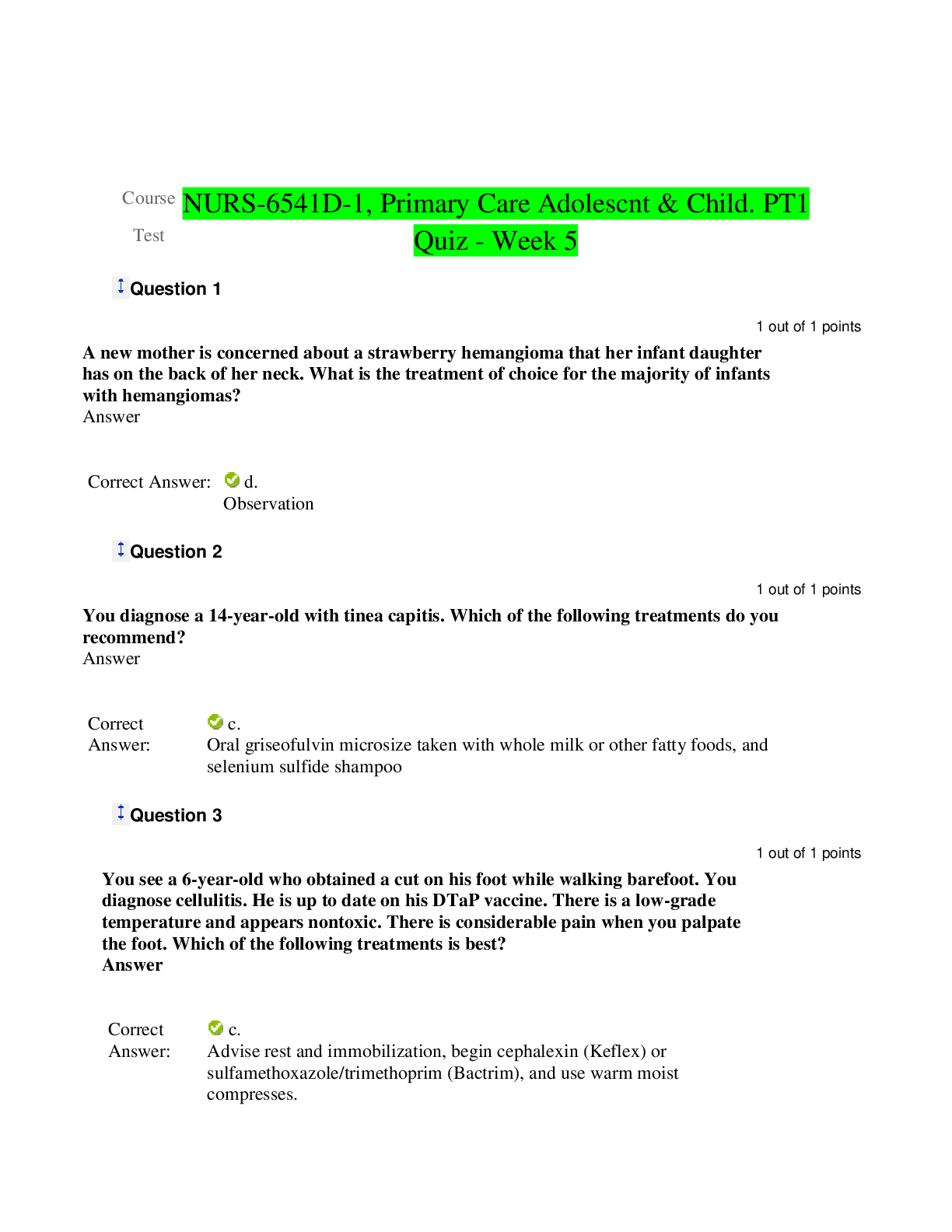


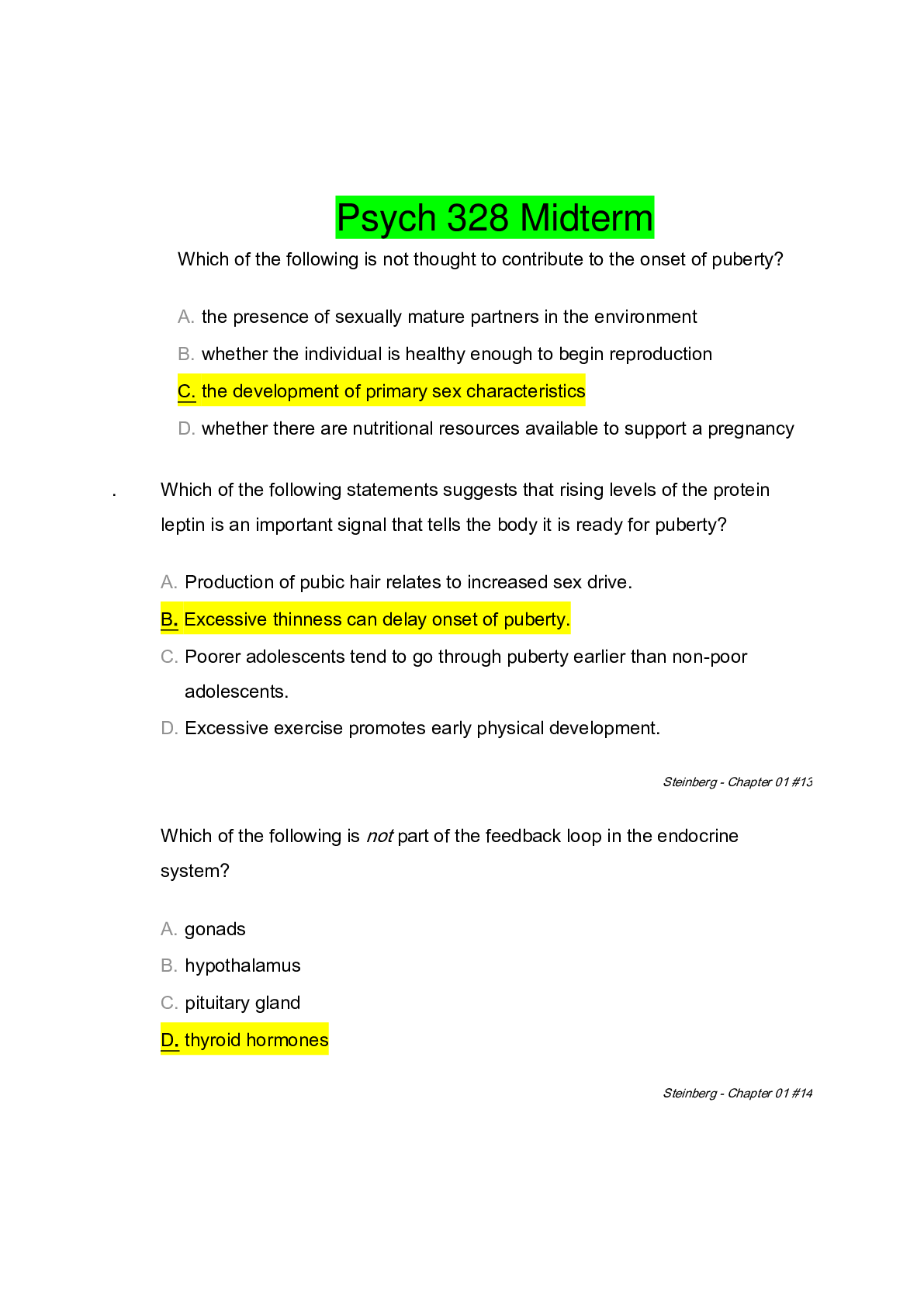
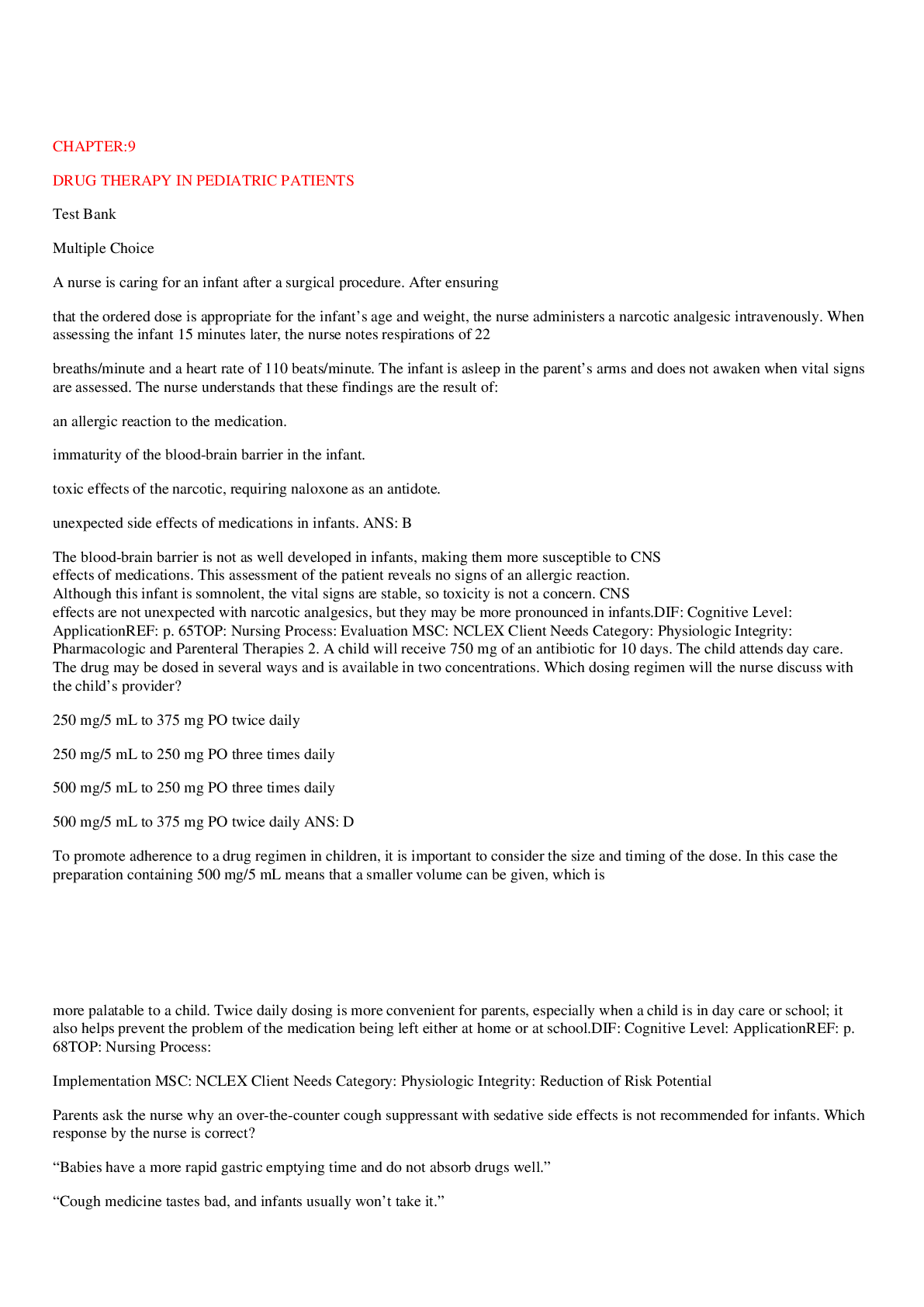
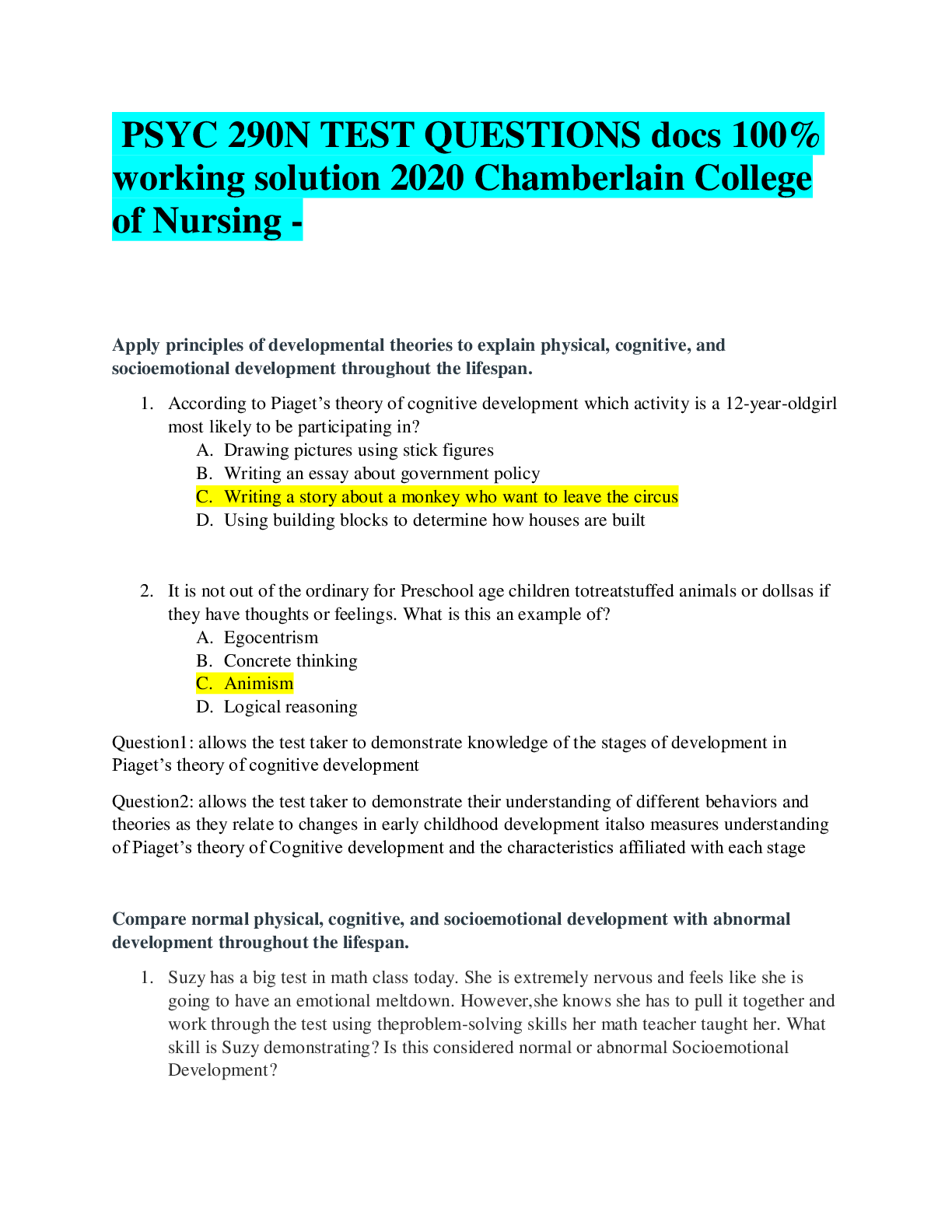


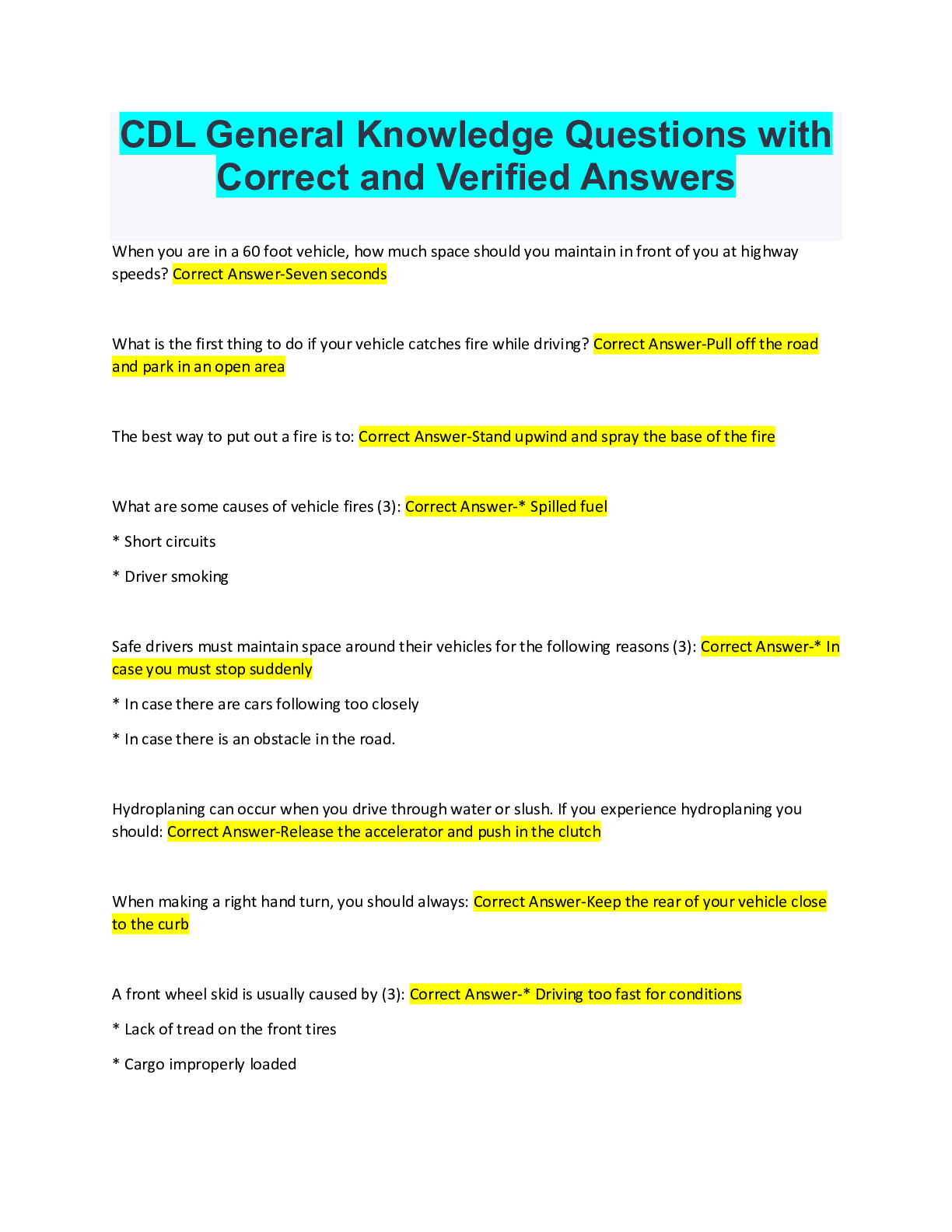
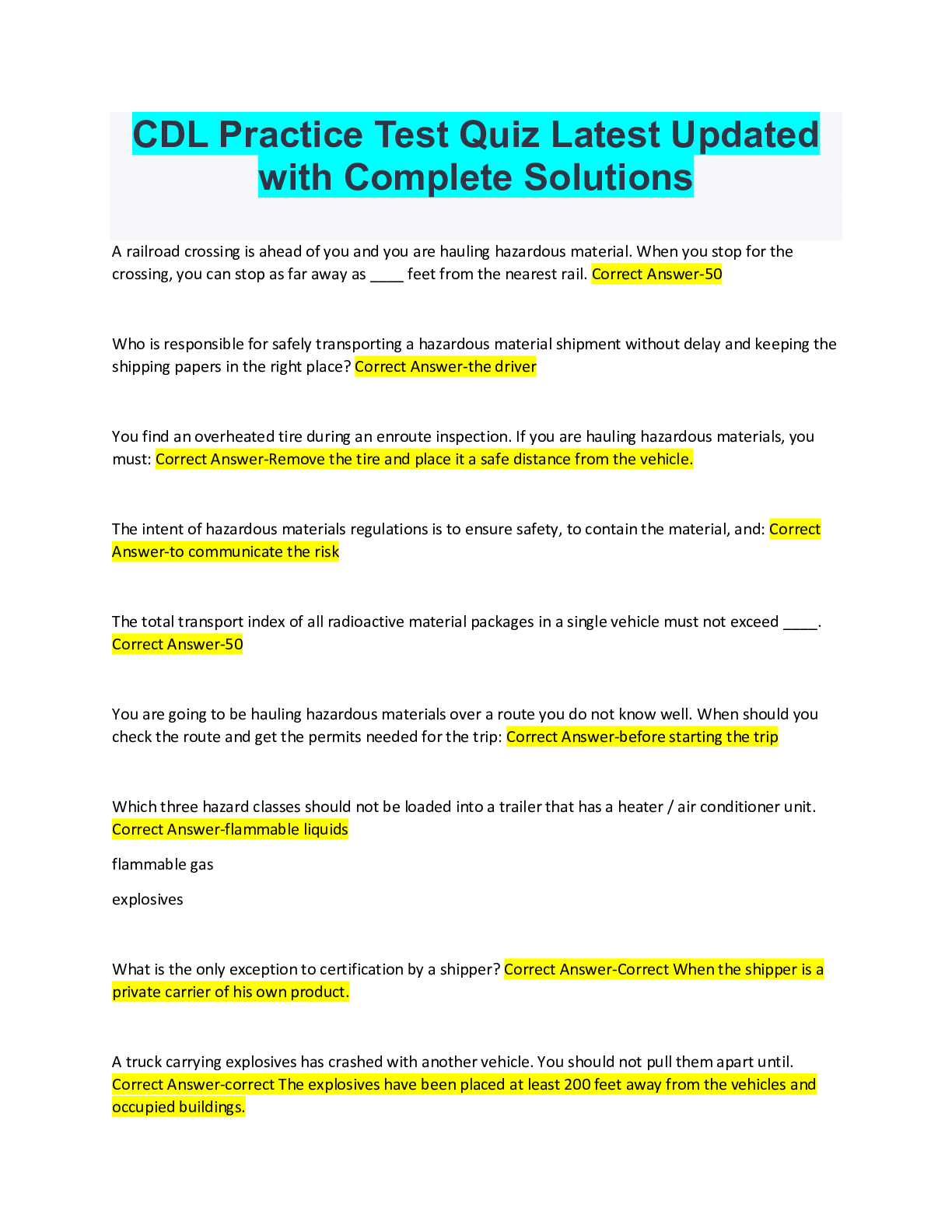

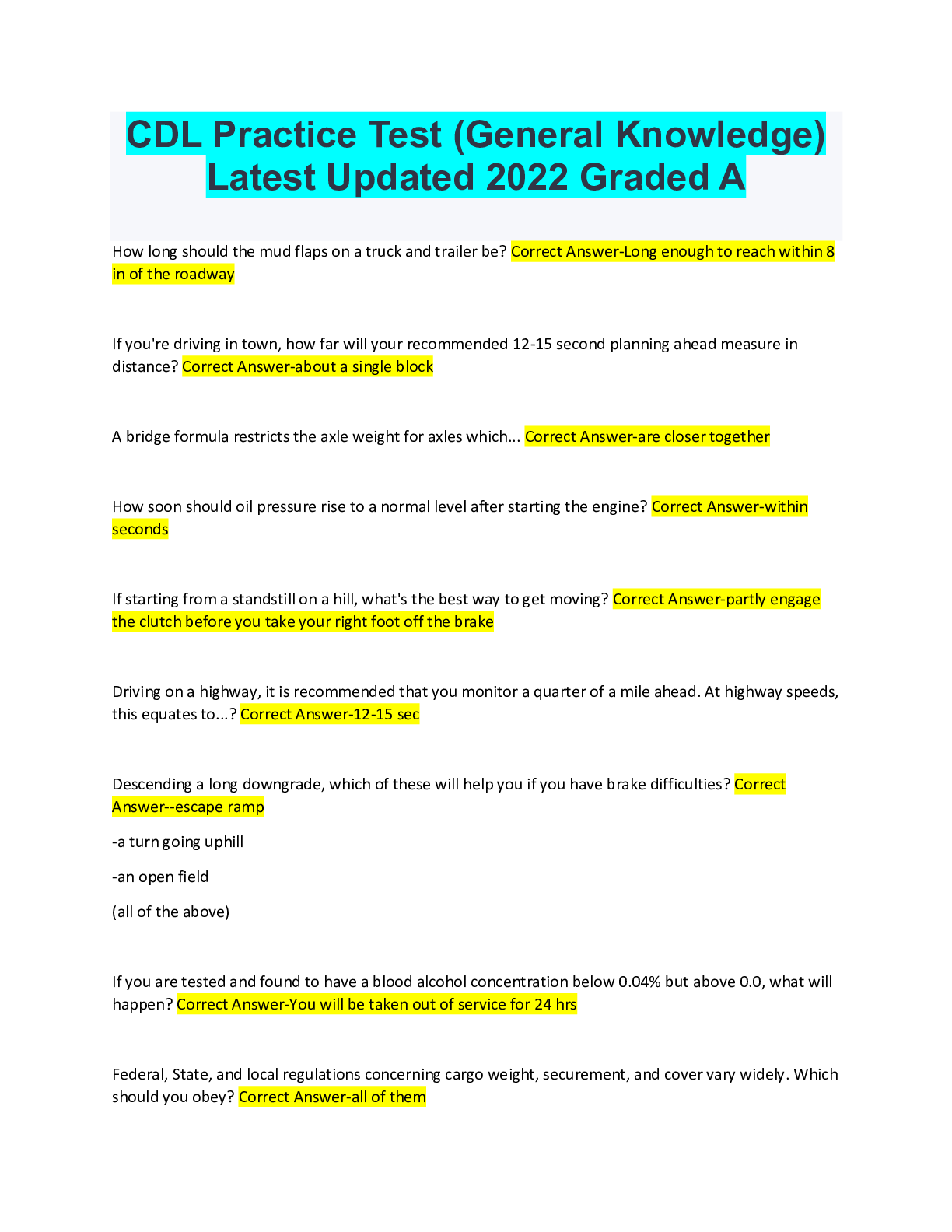
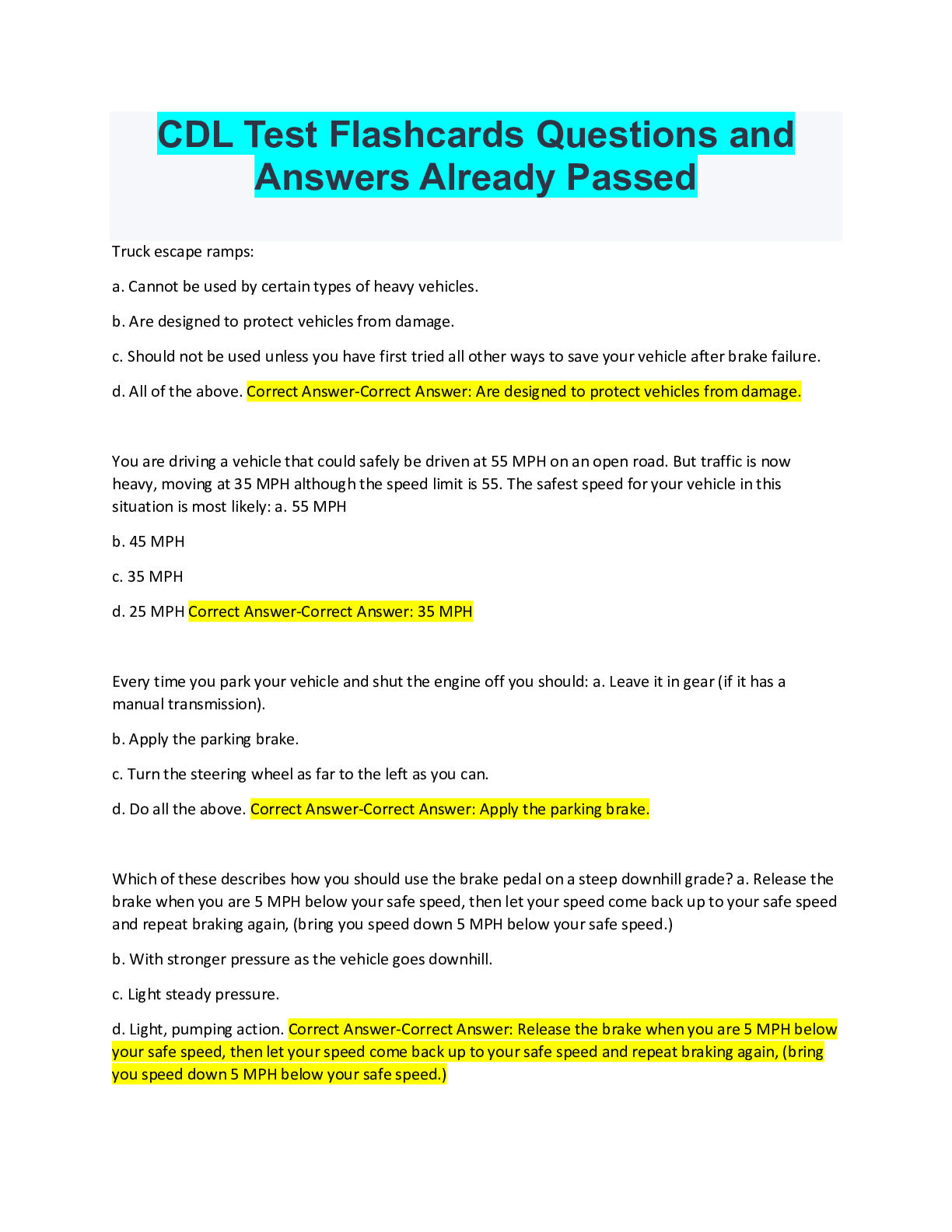
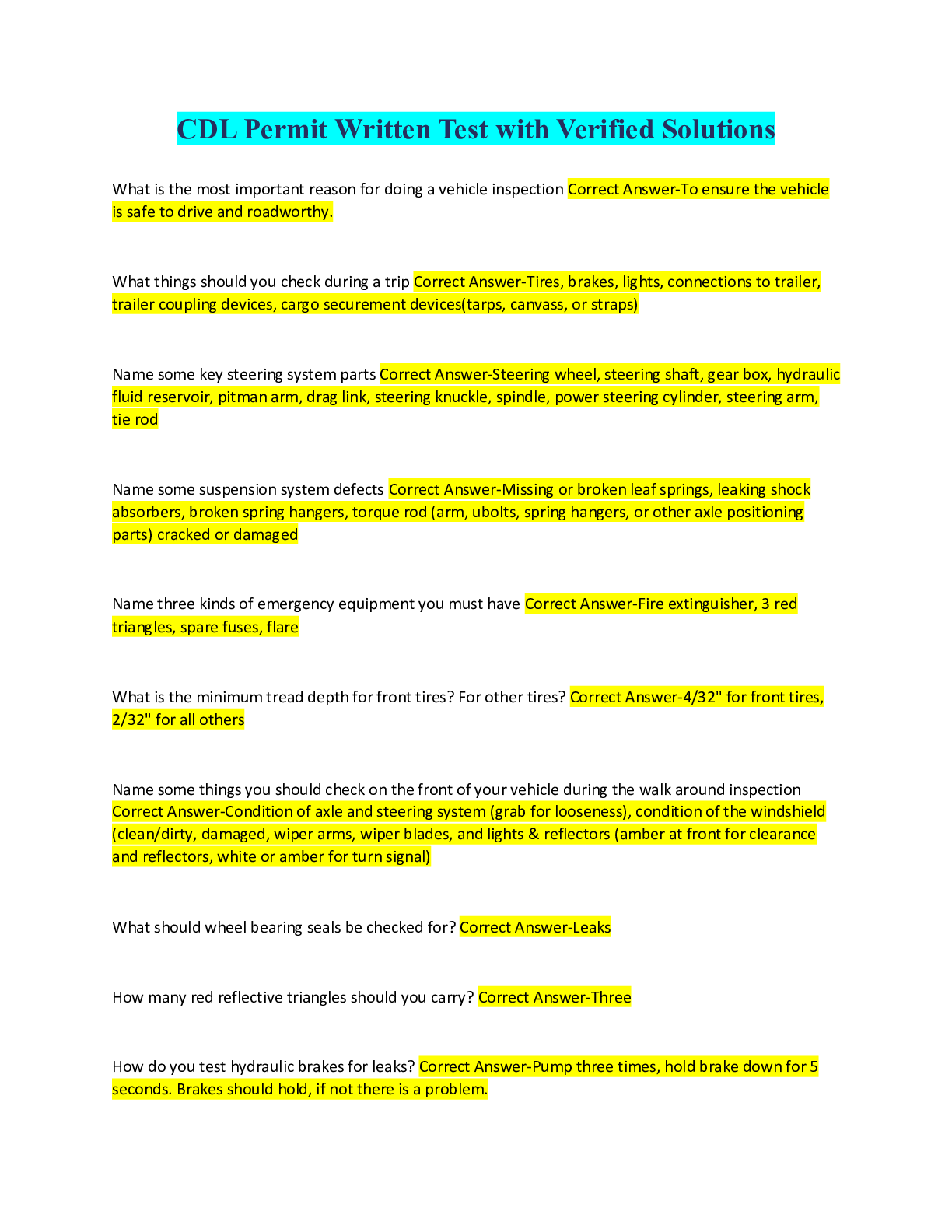

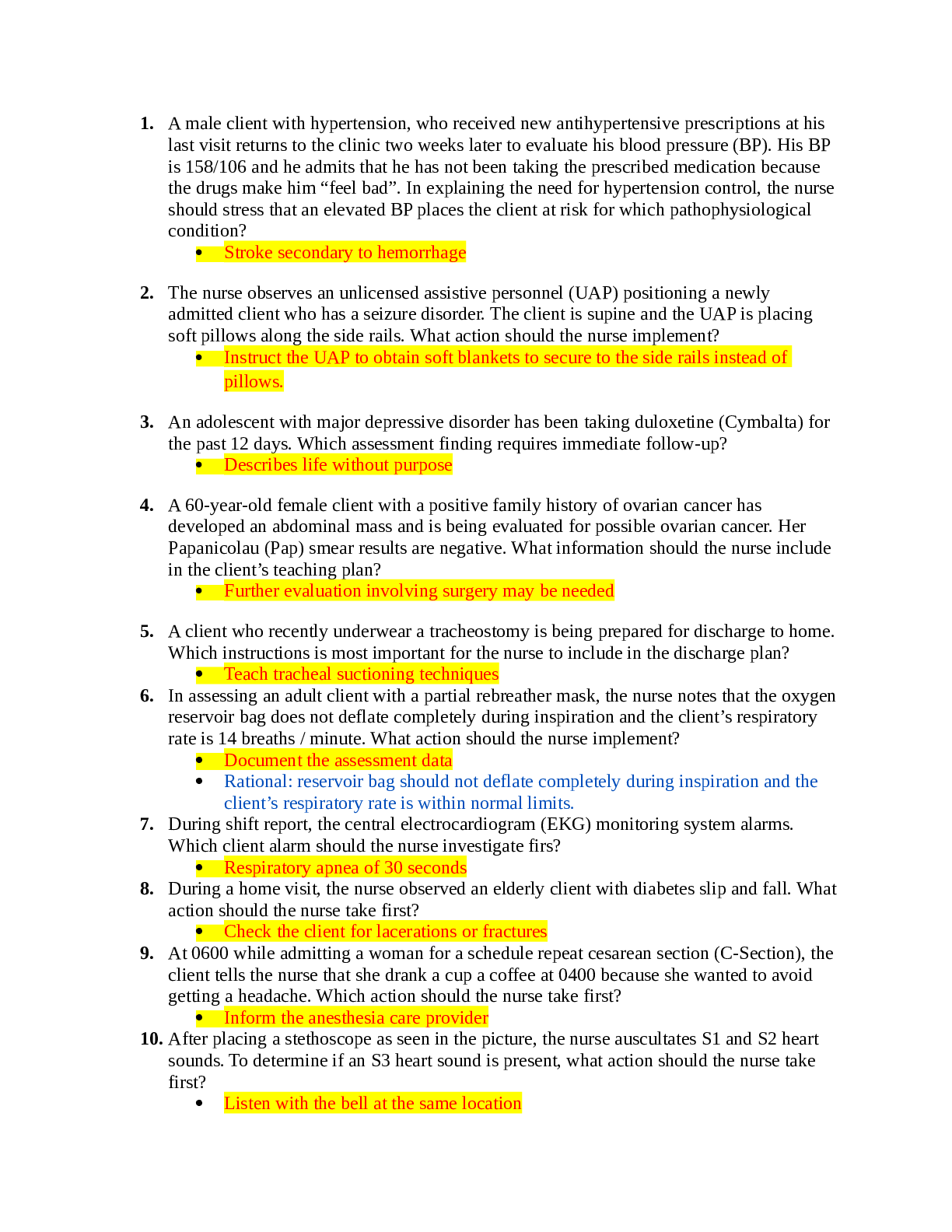

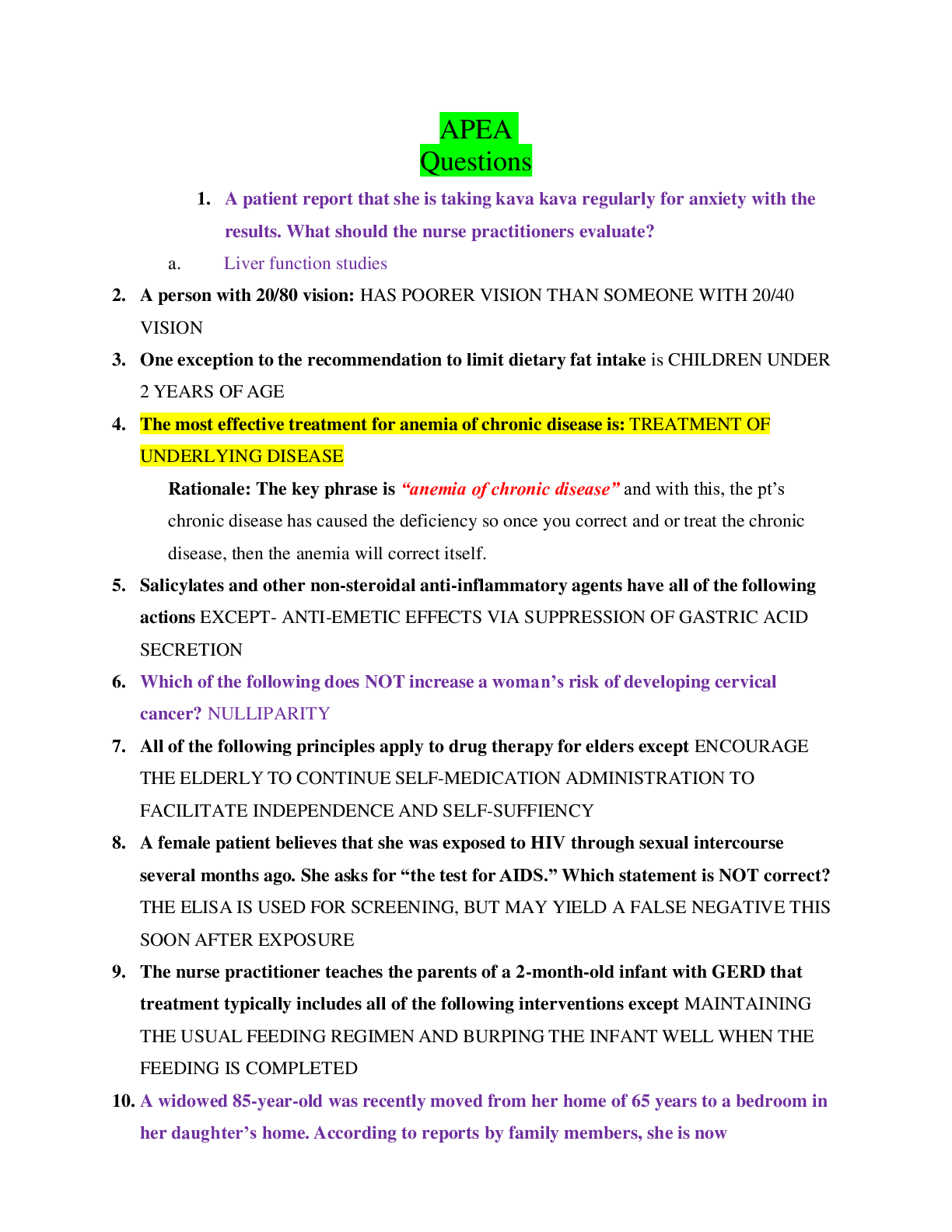




.png)


